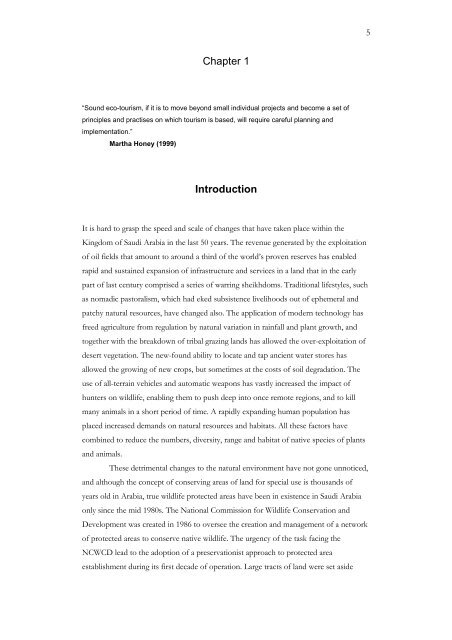The Unfenced Desert Towards a strategy for eco ... - Nwrc.gov.sa
The Unfenced Desert Towards a strategy for eco ... - Nwrc.gov.sa
The Unfenced Desert Towards a strategy for eco ... - Nwrc.gov.sa
Create successful ePaper yourself
Turn your PDF publications into a flip-book with our unique Google optimized e-Paper software.
Chapter 1<br />
“Sound <strong>eco</strong>-tourism, if it is to move beyond small individual projects and b<strong>eco</strong>me a set of<br />
principles and practises on which tourism is based, will require careful planning and<br />
implementation.”<br />
Martha Honey (1999)<br />
Introduction<br />
It is hard to grasp the speed and scale of changes that have taken place within the<br />
Kingdom of Saudi Arabia in the last 50 years. <strong>The</strong> revenue generated by the exploitation<br />
of oil fields that amount to around a third of the world’s proven reserves has enabled<br />
rapid and sustained expansion of infrastructure and services in a land that in the early<br />
part of last century comprised a series of warring sheikhdoms. Traditional lifestyles, such<br />
as nomadic pastoralism, which had eked subsistence livelihoods out of ephemeral and<br />
patchy natural resources, have changed also. <strong>The</strong> application of modern technology has<br />
freed agriculture from regulation by natural variation in rainfall and plant growth, and<br />
together with the breakdown of tribal grazing lands has allowed the over-exploitation of<br />
desert vegetation. <strong>The</strong> new-found ability to locate and tap ancient water stores has<br />
allowed the growing of new crops, but sometimes at the costs of soil degradation. <strong>The</strong><br />
use of all-terrain vehicles and automatic weapons has vastly increased the impact of<br />
hunters on wildlife, enabling them to push deep into once remote regions, and to kill<br />
many animals in a short period of time. A rapidly expanding human population has<br />
placed increased demands on natural resources and habitats. All these factors have<br />
combined to reduce the numbers, diversity, range and habitat of native species of plants<br />
and animals.<br />
<strong>The</strong>se detrimental changes to the natural environment have not gone unnoticed,<br />
and although the concept of conserving areas of land <strong>for</strong> special use is thou<strong>sa</strong>nds of<br />
years old in Arabia, true wildlife protected areas have been in existence in Saudi Arabia<br />
only since the mid 1980s. <strong>The</strong> National Commission <strong>for</strong> Wildlife Conservation and<br />
Development was created in 1986 to oversee the creation and management of a network<br />
of protected areas to conserve native wildlife. <strong>The</strong> urgency of the task facing the<br />
NCWCD lead to the adoption of a preservationist approach to protected area<br />
establishment during its first decade of operation. Large tracts of land were set aside<br />
5

















